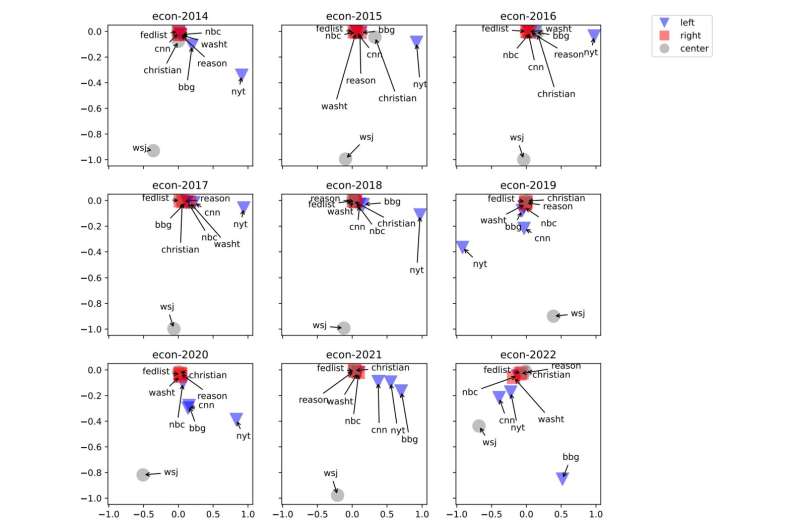This article has been reviewed according to Science X's editorial process and policies. Editors have highlighted the following attributes while ensuring the content's credibility:
fact-checked
trusted source
proofread
Study of headlines shows media bias is growing

News stories about domestic politics and social issues are becoming increasingly polarized along ideological lines according to a study of 1.8 million news headlines from major US news outlets from 2014 to 2022. A team from the University of Rochester led by Jiebo Luo, a professor of computer science and the Albert Arendt Hopeman Professor of Engineering, used machine learning to analyze headlines and presented their findings about growing media bias at the MEDIATE workshop of the International AAAI Conference on Web and Social Media.
The researchers said that while there is broad consensus that news media outlets adopt ideological perspectives in their articles, previous studies dissecting the differences among outlets were limited in scope and used small sample sizes. Machine-learning techniques allowed the researchers to study a vast sample of headlines over an eight-year period across nine representative media outlets including the New York Times, Bloomberg, CNN, NBC, the Wall Street Journal, Christian Science Monitor, the Federalist, Reason, and the Washington Times.
The study used a technique called multiple correspondence analysis to measure the fine-grained thematic discrepancies among headlines. The researchers grouped the stories into four categories—domestic politics, economic issues, social issues, and foreign affairs—and analyzed how left, right, and central media outlets differed in the language they used in their headlines.
The team observed that US media outlets across the political spectrum were consistent and similar in covering economic issues. While they found discrepancies in reporting foreign affairs, they attributed that to diversity in individual journalistic styles.
For example, the authors say the Wall Street Journal and Bloomberg primarily concentrate on the economic and financial implications of geopolitical tensions, resulting in differing perspectives compared to other media outlets. But headlines in the domestic politics and social issues categories showed important differences.
'Abortion law' or 'abortion rights'?
"We observed a lot of subtle differences in the words they choose when they cover the same high-level topics," says Hanjia Lyu, a computer science Ph.D. student who was the lead author of the study. "For example, when covering abortion issues, Reason tends to use the term 'abortion law,' while CNN underscores its ideological position by using the term 'abortion rights.' On a higher level they are both talking about abortion issues, but you can feel the subtle difference in the words that they choose."
The research team hopes to dig deeper to better understand how and why media outlets use different words to cover the same kind of topics. They say understanding these discrepancies, and when they may indicate media bias, is important for both media outlets and readers alike.
Says Luo: "For consumers, it's useful to know this information because the echo chamber effect is very strong and people are used to only listening to things they like to hear. Showing the divergence and the increased partisanship may make them aware that they need to be more conscious consumers of news."
More information: Bias or Diversity? Unraveling Fine-Grained Thematic Discrepancy in U.S. News Headlines, DOI: 10.36190/2023.25 workshop-proceedings.icwsm.org/pdf/2023_25.pdf
Conference: digitalmediasig.github.io/Mediate2022/
Provided by University of Rochester




















